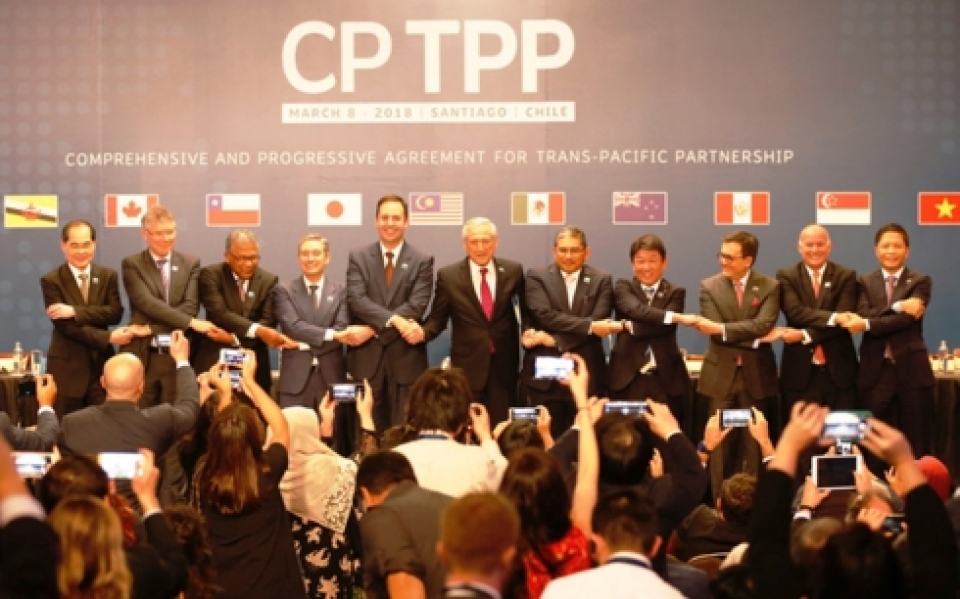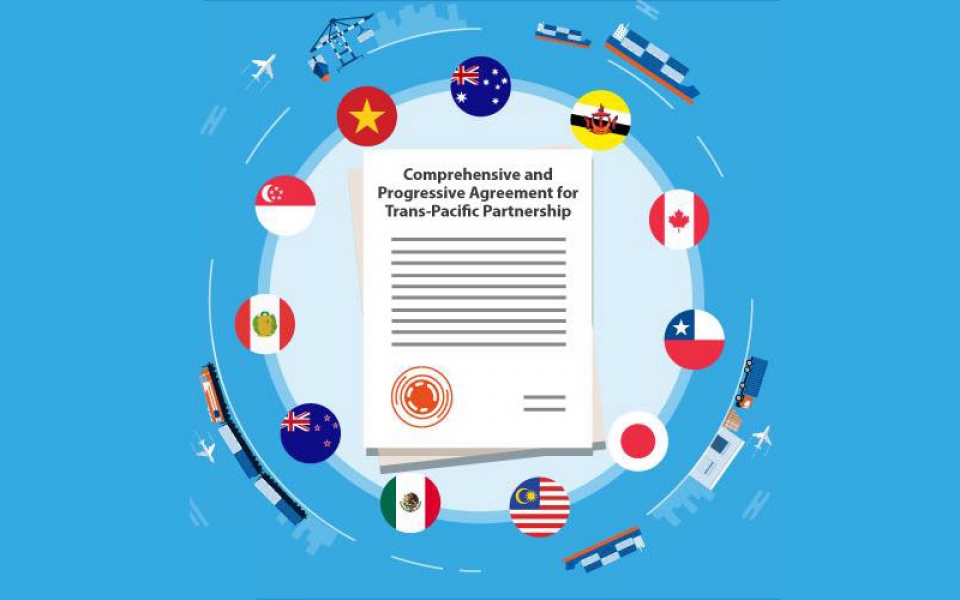
CPTPP tariff cuts and SOE monopoly removal usher in opportunities
Latest
| TIN LIÊN QUAN | |
| Vietnam ready to seize new opportunities | |
| Circular on certificates of origin in CPTPP issued | |
The Ministry of Finance recently submitted a proposal to the prime minister on the promulgation of a decree on a special preferential import and export tariff scheme for Vietnam to implement its commitments under the CPTPP for the 2019-2022 period.
This decree is expected to enter into force in the first half of this year.
Under the proposal, as for export tariff commitments for the CPTPP, Vietnam promises to erase all export tariffs for the majority of items that are currently subject to this type of tariff, in accordance with a roadmap of five-15 years after the CPTPP comes into force. Actually, the CPTPP took effect on January 14, 2019 for Vietnam.
 |
| The CPTPP is a free trade agreement between Australia, Brunei, Canada, Chile, Japan, Malaysia, Mexico, New Zealand, Peru, Singapore and Vietnam. |
A number of important items such as fossil coal, crude oil, and some types of ores and natural minerals (70 items) are permitted to continue their export tariffs.
Vietnam’s preferential export tariff scheme covers 519 tariff lines, with different levels of average tax rates to be truncated step by step, with 2019 (19.1%), 2020 (17.4%), 2021 (15.7%), and 2022 (14.1%).
Meanwhile, as for import tariff commitments for the CPTPP, Vietnam promises to erase close to 100% of tariff lines, under a roadmap.
Specifically, 65.8% of tariff lines will see a 0% import tax rate immediately after the CPTPP takes effect. Furthermore, in the fourth and 11th years after the entry into force of the deal, a total 86.5% and then 97.8%, respectively, of tariff lines will also enjoy a 0% import tax rate.
The remaining items will witness a 0% import tax rate in the 16th year or depending on tariff quotas.
Vietnam’s preferential import tariff schedule includes 10,216 tariff lines. The average tax rates will be reduced gradually, from 9.1% in 2019 to 7.7% in 2020, 6.3% in 2021, and 4.8% in 2022.
Removing state ownership in enterprises
Under the CPTPP, after the deal comes into force, all SOEs of all member states are required to operate equally under the market mechanism. Besides, they are banned from conducting anticompetitive practices, while having to make all their operational information transparent.
Specifically, under the deal’s Chapter 17, each member state, “shall ensure that each of its designated monopolies does not use its monopoly position to engage in, either directly or indirectly, including through its dealings with its parent, subsidiaries or other entities the party or the designated monopoly owns, anticompetitive practices in a non-monopolised market in its territory that negatively affect trade or investment between the parties.”
Also under this chapter, all SOEs of CPTPP member states have to ensure transparency in operation and information provision.
 |
| The benefits of the CPTPP are attracting other economies. |
Specifically, each Party shall provide to the other parties, or otherwise make publicly available on an official website, a list of its state-owned enterprises no later than six months after the date of entry into force of this agreement for that party, and thereafter shall update the list annually.
However, this regulation “shall not apply until five years from the date of entry into force of this agreement for Vietnam.”
Notably, on the written request of another party, a party shall promptly provide the following information concerning an SOE or a government monopoly, provided that the request includes an explanation of how the activities of the entity may be affecting trade or investment between the parties.
The information requested relates to the percentage of shares that the party, its SOEs or designated monopolies cumulatively own, and the percentage of votes that they cumulatively hold, in the entity; a description of any special shares or special voting or other rights that the party, its SOEs or designated monopolies hold, to the extent these rights are different than the rights attached to the general common shares of the entity; the government titles of any government official serving as an officer or member of the entity’s board of directors and the entity’s annual revenue and total assets over the most recent three year period for which information is available.
Great benefit
According to a CPTPP governmental report delivered to the National Assembly, in general, the CPTPP will greatly benefit Vietnam as its GDP is roughly US$11 trillion, or 13.5% of global GDP, including Japan as the world’s third largest economy. Its total export-import turnover is over US$10 trillion.
Under a study recently conducted by Vietnam’s Ministry of Planning and Investment, the CPTPP can expand the country’s GDP and export turnover by 1.32% and 4.04%, respectively, until 2035. Total import turnover will also likely rise by an additional 3.8% until 2035.
“In terms of investment attraction, CPTPP commitments about services and investment will help Vietnam improve its investment climate and attract more foreign direct investment (FDI),” said the report. “In terms of institutional reforms, CPTPP will help Vietnam further its improvements of the local business and investment climate in favour of enterprises.”
 |
| CPTPP can expand the country’s GDP and export turnover by 1.32% and 4.04%, respectively, until 2035. (Photo: Vietnamnet) |
Also according to the study, CPTPP will also increase the number of jobs by an additional 20,000-26,000 jobs per year.
Under statistics by the MPI, as of 2018, CPTPP member states had approximately 7,570 valid investment projects in Vietnam, with total registered investment capital of more than US$124 billion, accounting for 36.45% of the country’s total registered FDI.
To break down the figure, Australia had investments worth US$1.865 billion in Vietnam, while many other nations also had big investments, such as Brunei (US$1 billion), Canada (US$5 billion), Chile (US$15,000), Japan (US$57 billion), Malaysia (US$12.5 billion), Mexico (US$58,000), New Zealand (US$92.1 million), and Singapore (US$46.62 billion).
 | CPTPP to cause dramatic changes in domestic market in 2019 The domestic market is expected to see considerable changes in 2019 as the Comprehensive and Progressive Agreement for Trans-Pacific Partnership (CPTPP) became effective as from ... |
 | Vietnam targets 40 billion USD in textile-garment exports in 2019 The Vietnam Textile and Apparel Association (VITAS) has set the industry’s export turnover target this year at 40 billion USD, a 10.8 percent year-on-year increase ... |
 | Vietnamese enterprises urged to be more proactive to utilise CPTPP Master Phung Thi Lan Phuong, Head of the Free Trade Agreement Office under the WTO and Integration Centre, under the Vietnam Chamber of Commerce and ... |

























